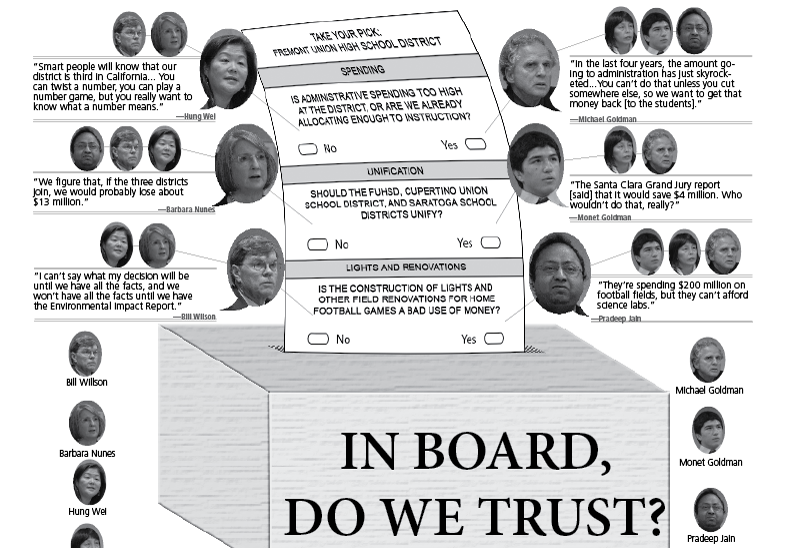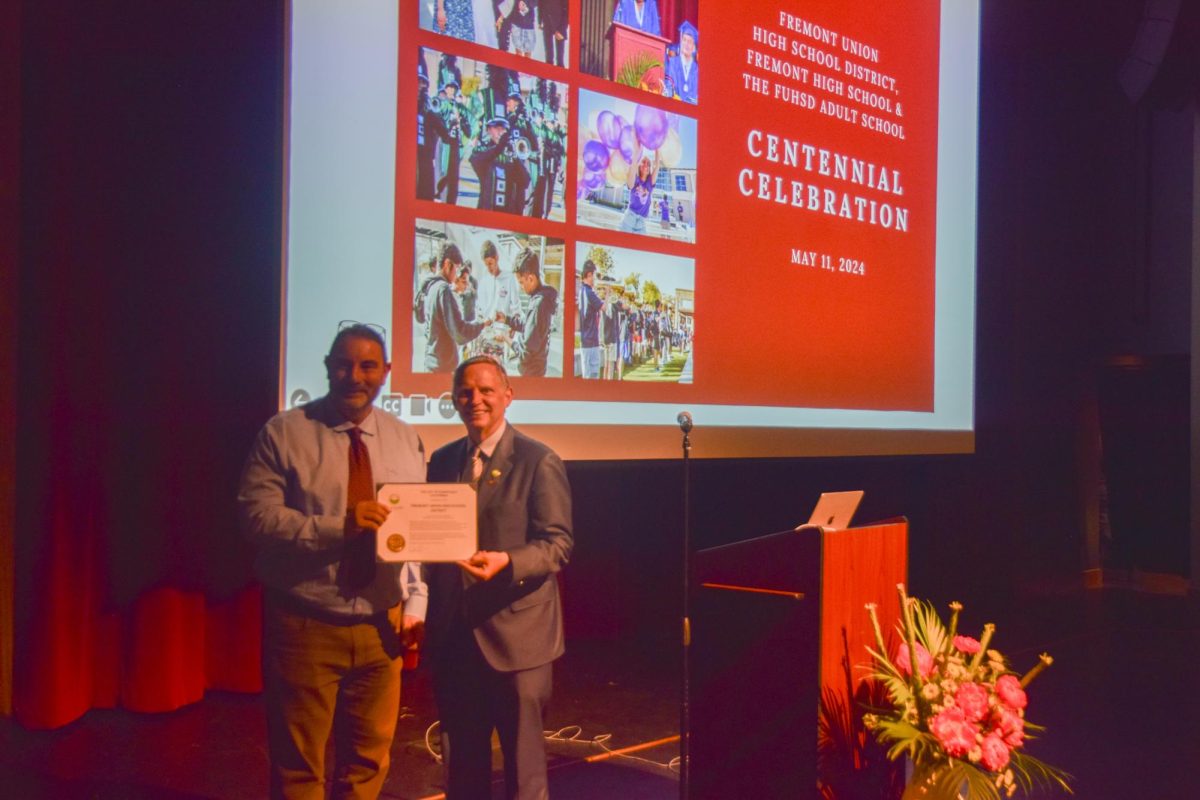 FUHSD Board of Trustees election presents a potential challenge to district spending policies
FUHSD Board of Trustees election presents a potential challenge to district spending policies

A majority of the five-member FUHSD Board of Trustees will be up for grabs on Nov. 2, as seven candidates vie for the three available seats. Incumbents Bill Wilson, the president, and Hung Wei, the clerk, hope to be elected for the second time, while Vice President Barbara Nunes is aiming for a third four-year term. Also in the mix are MVHS parent and engineer Pradeep Jain and the three-member family team of Michael, Miyuki Iwata, and Monet Goldman.
Much of the discord between the candidates centers around district spending. Particularly controversial is the Goldmans' "Better Fremont Union" website, which claims that administrative costs have doubled since the election of new board members in 2006.
The website claims that the FUHSD spends a smaller percentage of its revenue on instruction than any of the 26 largest school districts in Santa Clara County, but the data is disputed by the incumbents.
"[They've] got a fundamental misunderstanding of the facts in the case," Wilson said, "and I do think that it's important for a school board member to do a little bit of homework and figure out what figures mean."
A source of the alleged confusion could be modifications in the way funds were categorized.
"The state changed the way it has the district code its money," Nunes said. "We've kept the same percentage [of administrative costs]; it's just that it's labeled differently. We've actually cut administration at the district office."
All four challengers are campaigning for wiser district spending. Jain's plan is to use more money in the classroom to maintain quality instruction and low student-teacher ratios.
"I want to see 5 percent [of the budget] re-allocated to teaching," he said. "If we do that, that's $6 million dollars…bottom line, the mission is teaching, not administration."
The Goldmans, in defense of the statistics on their website, assure that the data had been collected from a valid source which they provide links to online.
"I know that I have no credibility assigned to me, I have to prove everything," Michael Goldman said. "The district can just say something and, rightly or wrongly, people just will automatically believe that they're speaking the truth, although frankly, they lie a lot."
To reduce spending, the family is promoting the unification plan recommended by the Santa Clara County Civil Grand Jury on Sept. 30, 2009. The plan
called for the consolidation of several districts in the county—including the FUHSD, the Cupertino Union School District, and the Sunnyvale School District, which would be merged—to enhance communication between the high schools, middle, and elementary schools and save money spent on administration.
"We get the question over and over when we talk to people: 'Why are we supporting two administrations?'" Michael Goldman said of the FUHSD and CUSD. "And we think it needs to be looked at."
The Goldmans argue that after merging the three districts, the new body should split in two, with a larger district in Cupertino and a smaller one in Sunnyvale, preventing the smaller Sunnyvale schools from being overwhelmed.
The FUHSD, CUSD, and SSD have since declined the grand jury's plan, on the grounds that the proposed mega-district of 34,000 students would actually exceed the grand jury's own recommended maximum, resulting in losses rather than savings. All three incumbents agree.
"Unification wouldn't save us any money at all; as a matter of fact, it would cost us," Nunes said.
Besides $13 million in lost state funds, the incumbents argue that the FUHSD and CUSD parcel taxes would have to be reapproved for the mega-district as a whole. Voters living within the boundaries of the SSD, which does not have a parcel tax, could tip the scales against such a measure—meaning $9 million more down the drain.
The Goldmans see things differently, pointing out that the parcel taxes will have to be renewed in a few years anyway. Jain expects that combining the districts would foster more effective communication between the schools. As a proponent of administrative transparency, however, he thinks that unification would have a negative outcome overall.
"The short answer is no, I don't really think that [unification] will achieve anything—it will actually give the administrators more opacity and more power," Jain said. "The long answer is that yes, I want unification, in the sense that one of our biggest problems is that the middle schools don't really coordinate with the high schools."
If the districts are eventually unified by the new board, personnel changes would result in order to prevent redundancy.
Also widening the chasm between the candidates is the planned installation of lights and other field renovations for home football games at FUHSD schools, which have brought up questions regarding the balance between spending on athletics and academics.
"It's pretty ridiculous," Monet Goldman, a Fremont High School class of 2010 alum and former wrestler, said. "Money shouldn't be going toward sports when the necessity of education isn't being invested in."
Some of the Measure B bond funds approved by voters, however, are specifically allocated to "renovate, replace or construct physical education and athletic fields."
The incumbents are currently re-evaluating the plan for the lights and will take into account upcoming Environmental Impact Reports and the community's wishes. Wei insisted that the process is still very open and that the district is going through the planning stages to keep all its options available.
"We can't invite 10,000 neighbors to come and design this," she said, "but they have not missed anything. Everything that they see is what we see."
Wilson said that he hopes to strike a balance between the convenience the renovations would afford students and the added noise and traffic that would result.
"The advantages to students are the ability to play games at their home school instead of having to drive across Cupertino, lugging all of their equipment with them, and the schedule flexibility that would come from being able to have practices early in the evening in the wintertime," he said. "But there definitely would be impact on the neighbors."
MVHS neighbors argued against the construction at a board meeting on Jan. 25, mentioning that upon moving in, the school had informally agreed not to construct lights. That claim, as well as the environmental, athletic, and financial impacts of the lights, will all be weighed when the board decides.
But the people who may take part in that decision have yet to be chosen, as new terms start in December. The elected trustees will represent the majority on the board, so the outcome has the potential to steer district spending policy for the next four years.
The fates of spending allocation, the unification plan, and the installation of football lights hang in the balance.





















